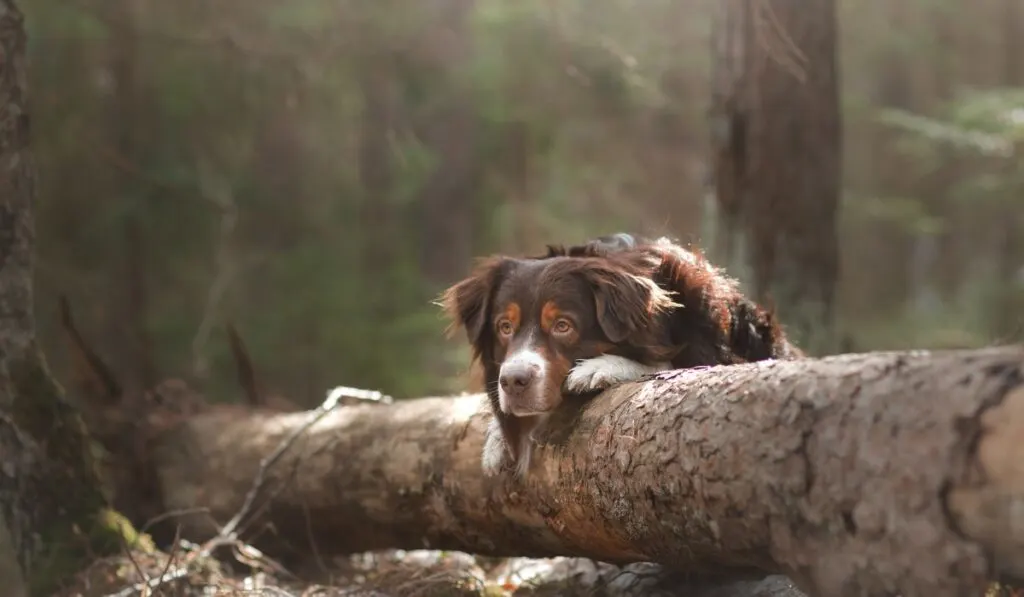Australian Shepherds and Pitbulls are two very different dog breeds, each with their own unique set of characteristics and temperaments.
While some dog breeds may be more compatible than others, there are several factors that can determine whether these two breeds can get along.
In this article, I will explore the traits of each breed, examine the potential challenges of mixing these two breeds, and provide tips on how to ensure a successful relationship between your Australian Shepherd and Pitbull.
Let’s get started!

Can These Two Breeds Get Along?
The ultimate answer is yes, australian shepherds and pitbulls can definitely get along. But there are a few determining factors.
➡️ In my experience, by far the most important factor is: socialization, followed by the gender of the two dogs
This is what determines just how easy it will be for two dogs to get along.
Now, if both the australian shepherd and pitbull are very well socializaed from a young age, then they will almost always get along and be able to develop a quick and friendly relationship with one another regardless of age.
Gender would likely still play a factor and it’s far easier for a male and female to work than both the same. But again, with very well-socialized dogs, it can still work with caution.
➡️ When it’s harder to know if they’ll get along:
Things get a little bit more difficult to determine if both or one of the dogs is not well-socializaed. Then it comes down to factors like their age, gender, how they are introduced, whose territority they are on, and more.
All will be explained in full detail below starting with the basic traits of both breeds.
Personal take:
After running The Puppy Mag for many years, I’ve spoken to several owners who own both a pitbull and an aussie. And of course, they are thick as thieves! “Inseperable” is how every owner has described their relationship. They match each others temperament, exercise needs, play style, and more. So I know for sure these two breeds can easily get along with each other.
Basic Traits of Australian Shepherds

Australian Shepherds are a medium-sized breed that was developed to herd and protect livestock. They are known for their high energy, intelligence, and loyalty to their owners.
Some common traits of Australian Shepherds include:
- Athletic and energetic
- Intelligent and eager to please
- Loyal and protective of their family
- Good with children and other pets if socialized properly
- Can be stubborn and independent-minded
- Require regular exercise and mental stimulation
Basic Traits of Pitbulls

Pitbulls are a group of dog breeds that were originally bred for bull-baiting and fighting.
➡️ Despite their reputation for aggression, with proper training and socialization, Pitbulls can make wonderful pets and are incredibly friendly and gentle.
Some common traits of Pitbulls include:
- Strong and muscular
- Loyal and affectionate with their family
- Good with children and other pets if socialized properly
- Energetic and playful
- Can be stubborn and independent-minded
- Require regular exercise and mental stimulation
Potential Challenges of Mixing Australian Shepherds and Pitbulls
While both Australian Shepherds and Pitbulls can make great pets, there are some potential challenges that can arise when these two breeds are mixed.
Some of these challenges include:
- Dominance issues: Both breeds can be strong-willed and independent, which can lead to dominance struggles if not properly managed. This is also heavily influenced by gender. Opposite genders will have far less dominance issues than two of the same gender together.
- Energy levels: Both breeds require a lot of exercise and mental stimulation, so if they do not get enough activity, they may become restless and destructive.
- Prey drive: Pitbulls were originally bred to hunt and kill small animals, so if they have a strong prey drive, they may see smaller pets like cats or rabbits as prey, which can be dangerous for them and the other pet.
- Socialization: Proper socialization is key for both breeds to get along with other pets, including each other. If they are not socialized properly, they may be prone to aggression or fear towards other animals.
When this pair might not work out
This relationship can be MUCH harder to nuture if we are talking about bringing in an adult pitbull or aussie, into a home with an existing adult pitbull or aussie especially if any of them are a rescue.
Rescues have previous trauma that owners often don’t know the extent of, and bringing in another dog with with or without the same trauma can be too much for both of them.
This can then cause them to act out aggressively (usually from fear) when their owner has never seen them be aggressive before.
So, while this is a great pairing in general, there are definitely circumstances when this may not work out.
Tips for bringing another dog into another dog’s territory
If one of the dogs is going into the territory or home of the other, it is important to take extra precautions to ensure a smooth introduction and minimize any potential conflicts.
Here are some things that owners need to know when bringing Australian Shepherds and Pitbulls together in this scenario:
- Start on neutral territory: Bringing the two dogs together on neutral territory first goes a long way in establishing a base relationship. Let these two dogs sniff each other and play with each other at the dog park first so they get to know one another. This can make it easier for their second interaction at the home.
- Introduce them slowly: When bringing a new dog into the home, it is important to introduce them slowly and in a controlled manner. This can help prevent any territorial aggression or fear-based aggression. Start by keeping the dogs in separate rooms or crates, and gradually introduce them to each other in short, supervised sessions. Watch their body language and behavior closely, and be ready to separate them if necessary.
- Use positive reinforcement: Use positive reinforcement to encourage good behavior and discourage bad behavior. Reward your dogs for calm and friendly behavior, and redirect any aggressive or fearful behavior with a distraction or command. Avoid punishment or physical corrections, as this can lead to increased aggression and fear.
- Provide separate resources: Each dog should have their own food and water bowls, toys, and sleeping areas. This can help prevent resource guarding and territorial aggression.
- Monitor them closely: Until you are sure that both dogs are getting along well, monitor them closely. This includes meal times, playtime, and any interactions. Never leave them alone together until you are confident that they can be trusted.
- Seek professional help if needed: If your dogs are not getting along, or if you are having difficulty managing their behavior, seek the help of a professional dog trainer or behaviorist. They can provide you with the guidance and tools you need to help your dogs get along and live happily together.
In summary, introducing Australian Shepherds and Pitbulls to each other in a home or territory requires patience, planning, and supervision. By introducing them slowly, using positive reinforcement, providing separate resources, monitoring them closely, and seeking professional help if needed, you can help ensure a successful introduction and a harmonious relationship between your two dogs.
Tips for Ensuring a Successful Relationship
If you are considering bringing an Australian Shepherd and a Pitbull into the same household, there are several things you can do to ensure a successful relationship between them.
Some tips include:
- Start with a meet and greet: Before bringing either dog into your home, introduce them in a neutral location, such as a park or a friend’s backyard. This will help them get to know each other in a low-stress environment.
- Supervise all interactions: Until you are sure that both dogs are getting along well, supervise all interactions between them. This includes meal times, playtime, and walks.
- Socialize both dogs: Both breeds require socialization to help them get along with other animals. This includes introducing them to other dogs, cats, and small animals in a controlled and positive manner.
- Train both dogs: Both breeds require obedience training and socialization to help them get along with other animals. This includes teaching them basic commands, such as “sit” and “stay,” as well as positive reinforcement training.
- Provide plenty of exercise and mental stimulation: Both breeds require a lot of exercise and mental stimulation to keep them healthy and happy. This includes daily walks, playtime, and training sessions.
- Seek professional help if needed: If your dogs are not getting along, or if you are having difficulty managing their behavior, seek the help of a professional dog trainer or behaviorist. They can provide you with the guidance and tools you need to help your dogs get along and live happily together.
Conclusion
In conclusion, whether or not Australian Shepherds can get along with Pitbulls depends on several factors, including their individual temperaments, socialization, and training.
While there may be some challenges in mixing these two breeds, with proper socialization, training, and supervision, it is possible for them to live happily together.
By following the tips outlined in this article, you can help ensure a successful relationship between your Australian Shepherd and Pitbull, and enjoy the many benefits of having two loving and loyal pets in your home.
